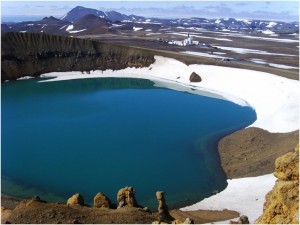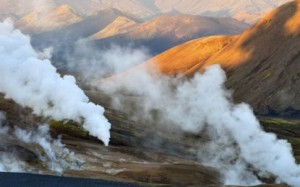30 Jun 2014
The expansion of geothermal energy keeps growing: from Island to Japan
World’s first magma-EGS system created in Iceland
In 2009, a borehole drilled at Krafla, northeast Iceland, as part of the Icelandic Deep Drilling Project (IDDP), unexpectedly penetrated into magma (molten rock) at only 2100 meters depth, with a temperature of 900-1000 C. The borehole, IDDP-1, was the first in a series of wells being drilled by the IDDP in Iceland in the search for high-temperature geothermal resources.

The January 2014 issue of the international journal Geothermics is dedicated to scientific and engineering results arising from that unusual occurrence.
Accordingly, a steel casing, perforated in the bottom section closest to the magma, was cemented into the well. The hole was then allowed to heat slowly and eventually allowed to flow superheated steam for the next two years, until July 2012, when it was closed down in order to replace some of the surface equipment. In the future, the success of this drilling and research project could lead to a revolution in the energy efficiency of high-temperature geothermal areas worldwide.
The IDDP is a collaboration of three energy companies — HS Energy Ltd., National Power Company and Reykjavik Energy — and a government agency, the National Energy Authority of Iceland. It will drill the next borehole, IDDP-2, in southwest Iceland at Reykjanes in 2014-2015.
Japan’s first new geothermal power plant in 15 years
The new geothermal plant is located in a region famed for its natural hot springs and volcanic activity in Kumamoto prefecture on the southern island of Kyushu.
The project has been masterminded by the Chuo Electric Power Co, which has set up a dedicated company devoted to geothermal activities and plans to open five further plants over the next five years.
The plant – the first to open in Japan since 1999 – will mark the start of a flurry of geothermal projects launching across the country, with a string of other companies following suit from northernmost Hokkaido to southern Kyushu.
Japan is famously one of world’s most seismically active nations, with its geothermal resources estimated to be able to generate as much as 23 million kilowatts of energy, the third largest amount in the world after the United States and Indonesia.
The Kumamoto plant is being developed alongside the local company Waita-kai, in the small hot spring resort Oguni, with a planned maximum output of 2,000 kilowatts to cater for 1,500 households.
The launch of such small-scale geothermal power plants is key to its expansion plans, creating a new energy source while revitalising local communities at the same time, according to Chuo Electric power Co.
